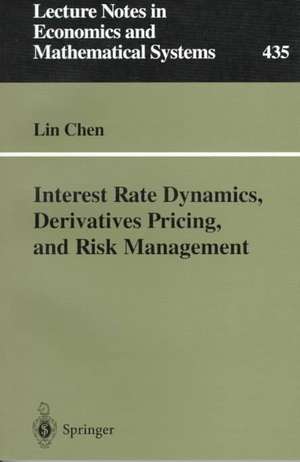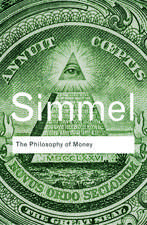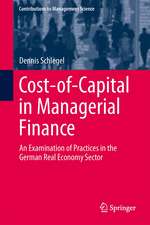Interest Rate Dynamics, Derivatives Pricing, and Risk Management: Lecture Notes in Economics and Mathematical Systems, cartea 435
Autor Lin Chenen Limba Engleză Paperback – 7 mar 1996
Din seria Lecture Notes in Economics and Mathematical Systems
-
 Preț: 360.02 lei
Preț: 360.02 lei -
 Preț: 383.93 lei
Preț: 383.93 lei -
 Preț: 384.09 lei
Preț: 384.09 lei -
 Preț: 380.07 lei
Preț: 380.07 lei -
 Preț: 446.26 lei
Preț: 446.26 lei -
 Preț: 497.37 lei
Preț: 497.37 lei -
 Preț: 380.84 lei
Preț: 380.84 lei -
 Preț: 384.86 lei
Preț: 384.86 lei -
 Preț: 378.34 lei
Preț: 378.34 lei -
 Preț: 399.67 lei
Preț: 399.67 lei - 20%
 Preț: 360.93 lei
Preț: 360.93 lei - 15%
 Preț: 643.16 lei
Preț: 643.16 lei -
 Preț: 379.09 lei
Preț: 379.09 lei -
 Preț: 404.74 lei
Preț: 404.74 lei -
 Preț: 385.62 lei
Preț: 385.62 lei - 15%
 Preț: 644.49 lei
Preț: 644.49 lei -
 Preț: 379.09 lei
Preț: 379.09 lei -
 Preț: 345.50 lei
Preț: 345.50 lei -
 Preț: 425.80 lei
Preț: 425.80 lei -
 Preț: 378.34 lei
Preț: 378.34 lei - 18%
 Preț: 775.65 lei
Preț: 775.65 lei -
 Preț: 392.60 lei
Preț: 392.60 lei -
 Preț: 401.61 lei
Preț: 401.61 lei - 15%
 Preț: 646.43 lei
Preț: 646.43 lei -
 Preț: 382.18 lei
Preț: 382.18 lei -
 Preț: 378.34 lei
Preț: 378.34 lei - 15%
 Preț: 637.59 lei
Preț: 637.59 lei - 15%
 Preț: 647.27 lei
Preț: 647.27 lei -
 Preț: 377.73 lei
Preț: 377.73 lei -
 Preț: 447.84 lei
Preț: 447.84 lei - 15%
 Preț: 644.49 lei
Preț: 644.49 lei -
 Preț: 386.00 lei
Preț: 386.00 lei - 15%
 Preț: 654.43 lei
Preț: 654.43 lei -
 Preț: 415.02 lei
Preț: 415.02 lei -
 Preț: 411.54 lei
Preț: 411.54 lei -
 Preț: 398.92 lei
Preț: 398.92 lei -
 Preț: 398.92 lei
Preț: 398.92 lei -
 Preț: 392.75 lei
Preț: 392.75 lei - 15%
 Preț: 635.47 lei
Preț: 635.47 lei - 20%
 Preț: 653.56 lei
Preț: 653.56 lei -
 Preț: 379.86 lei
Preț: 379.86 lei -
 Preț: 495.46 lei
Preț: 495.46 lei -
 Preț: 447.99 lei
Preț: 447.99 lei -
 Preț: 378.71 lei
Preț: 378.71 lei - 15%
 Preț: 637.13 lei
Preț: 637.13 lei -
 Preț: 385.84 lei
Preț: 385.84 lei -
 Preț: 378.54 lei
Preț: 378.54 lei - 15%
 Preț: 666.55 lei
Preț: 666.55 lei -
 Preț: 380.07 lei
Preț: 380.07 lei
Preț: 380.84 lei
Nou
Puncte Express: 571
Preț estimativ în valută:
72.89€ • 75.81$ • 61.08£
72.89€ • 75.81$ • 61.08£
Carte tipărită la comandă
Livrare economică 14-28 martie
Preluare comenzi: 021 569.72.76
Specificații
ISBN-13: 9783540608141
ISBN-10: 3540608141
Pagini: 168
Ilustrații: XII, 152 p.
Dimensiuni: 155 x 235 x 9 mm
Greutate: 0.25 kg
Editura: Springer Berlin, Heidelberg
Colecția Springer
Seria Lecture Notes in Economics and Mathematical Systems
Locul publicării:Berlin, Heidelberg, Germany
ISBN-10: 3540608141
Pagini: 168
Ilustrații: XII, 152 p.
Dimensiuni: 155 x 235 x 9 mm
Greutate: 0.25 kg
Editura: Springer Berlin, Heidelberg
Colecția Springer
Seria Lecture Notes in Economics and Mathematical Systems
Locul publicării:Berlin, Heidelberg, Germany
Public țintă
ResearchCuprins
1 A Three-Factor Model of the Term Structure of Interest Rates.- 1.1 Introduction.- 1.2 The Model.- 1.3 Benchmark Case.- 1.4 Green’s Function.- 1.5 Derivatives Pricing.- 1.6 The Term Structure of Interest Rates.- 1.7 Expected Future Short Rate.- 1.8 Forward Rates.- 2 Pricing Interest Rate Derivatives.- 2.1 Introduction.- 2.2 Bond Options.- 2.3 Caps, Floors, and Collars.- 2.4 Futures Price and Forward Price.- 2.5 Swaps.- 2.6 Quality Delivery Options.- 2.7 Futures Options.- 2.8 American Options.- 3 Pricing Exotic Options.- 3.1 Introduction.- 3.2 Green’s Function in the Presence of Boundaries.- 3.3 Derivatives with Payoffs at Random Times.- 3.4 Barrier Options.- 3.5 Lookback Options.- 3.6 Yield Options.- 4 Fitting to a Given Term Structure.- 4.1 Introduction.- 4.2 Merging to the Heath-Jarrow-Morton Framework.- 4.3 Whole-Yield Model.- 5 A Discrete-Time Version of the Model.- 5.1 Introduction.- 5.2 Construction of the Four-Dimensional Lattice.- 5.3 Applications.- 6 Estimation of the Model.- 6.1 Introduction.- 6.2 Kaiman Filter.- 6.3 Maximum Likelihood.- 6.4 Method of Moments.- 6.5 Simulated Moments.- 7 Managing Interest Rate Risk.- 7.1 Introduction.- 7.2 Generalized Duration and Convexity.- 7.3 Hedging Ratios.- 7.4 Hedging: General Approach.- 7.5 Hedging Yield Curve Risk.- 8 Extensions of the Model.- 8.1 Introduction.- 8.2 Extension I: Jumping Mean and Diffusing Volatility.- 8.3 Extension II: Jumping Mean and Jumping Volatility.- 9 Concluding Remarks.- A Proof of Lemma 1.- B Proof of Proposition 2.- C Proof of Lemma 2.- D Proof of Proposition 8.- E Integral Equation for Derivative Prices.














